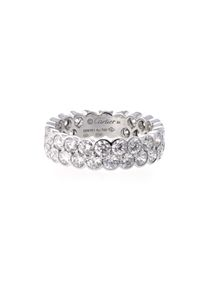Clear all filters
Cartier Jewellery collection
Découvrez nos 18 jewellery cartier. Tous les meilleurs modèles au meilleur prix, à acheter ou à rechercher.
All our Cartier jewel
CARTIER
18 items
Cartier, the story of a family beginning in the 19th century
A proud ambassador of French luxury and know-how, Maison Cartier is a family epic. It is the story of Louis-François Cartier, who in 1847 bought the jewelry workshop from his apprenticeship master, his sons, Alfred, Pierre Camille and Jacques Théodule, and his grandsons Louis Joseph, Pierre and Jacques. Louis-François and Alfred both hold prominent postions in the history of the House, not just for their wonderful creations, but also for their role in the influence and reputation Cartier enjoys to this day. Louis-François Cartier very quickly moved his workshop to the most fashionable area of Paris, the Place du Palais Royal, in 1853, and became known as the jeweller who knew how to meet the most extravagant demands of his clients. Among them, the Empress Eugenie. It was his son Alfred who, in 1899, launched the jewellery store on the rue de la Paix and entrusted his three sons, Louis Joseph, Pierre and Jacques, with the task of developing the brand throughout the world.
Cartier, the "Jeweller of Kings and King of Jewellers"
Cartier's creativity, inventiveness and the excellence of its craftsmanship enabled the family to quickly conquer the world as well as the hearts of the great and good. When Louis travelled the earth in search of inspiration and the most beautiful stones, his brother Jacques settled in London at the dawn of the 20th century. The Prince of Wales and future Edward VII ordered 27 tiaras for his coronation, before appointing Jacques as official jeweller of the English court and naming him "Jeweller of Kings and King of Jewellers". Pierre chose New York, where he opened his first boutique on Fifth Avenue in 1909, which is still open today. Believing there was no place for women in the Cartier's history would be an insult to Jeanne Toussaint, Louis' mistress and artistic director of the house from 1933 to 1970. The House owes a great deal to this jeweller and friend of Coco Chanel, as it was under her leadership that the panther became its emblem. She designed the first Panther collections of jewellery, rings, bracelets and lighters.
Inimitable style, iconic jewellery designs
In the world of French-style luxury Cartier has always stood out thanks to its avant-garde style. Just look at their Asian and Oriental inspired pieces from the early 20th century, as well as their jewellery in abstract and geometric shapes - imagine the style of Art Deco before its time. Cartier finds beauty in everything, then uses its free and daring approach to transform that beauty into sumptuous jewellery collections. This is the House's hallmark. Cartier's iconic models are remarkable not just because of the exquisiteness of their materials and stones, but also because of the power and character they possess. The bracelet love and its screws, and then the Juste un clou collection draw upon the energy of New York. The Trinity ring with its three gold bands became a cult-like object because it was so ahead of its time.
A pioneering watchmaking brand
This avant-garde approach is at the heart of the House of Cartier's creations, particularly in the field of watchmaking and under the leadership of Louis Joseph Cartier. Indeed, it was the eldest son who created the brand's first iconic models. Indeed it was he who created their first wristwatch, the Santos watch, in 1904. It was named after the Brazilian aviator Alberto Santos-Dumont, who did not find the use of pocket watches practical when he was flying. Marketed from 1911, the watch evolved over the decades, with key developments including the introduction of the gold and steel bracelet in 1978. This is often what happens with Cartier's most emblematic models. They start as precursors, then reinvent themselves with the passing of time and yet still remain true to the values of the brand to this day. Just think of, in particular, the Tank watch, which was first designed in 1917 and is now available today in versions for both men and women, the Pasha watch, created in the 1980s, or the Ballon model.
Each Cartier model is a work of art
Jewellery and watches very much remain the cornerstones of the House of Cartier. But the company, now part of the international Richemont Group, has diversified with collections of fragrances for men and women, accessories and eyewear, bags and wallets. With more than 200 boutiques open across 60 countries, the French brand is establishing itself as a true luxury giant. But the heart of Cartier still beats in Paris, with art and creativity still taking centre stage. From Jean Cocteau's academician's sword to the Mughal emerald in the Berenice necklace, the House began buying back jewellery, watches and other objects in the 1980s to build its historical collection. The brand is also committed to cultural patronage, once again again displaying its trailblazing spirit with the creation of the Cartier Foundation for Contemporary Art based in Jouy-en-Josas, in the Yvelines.















